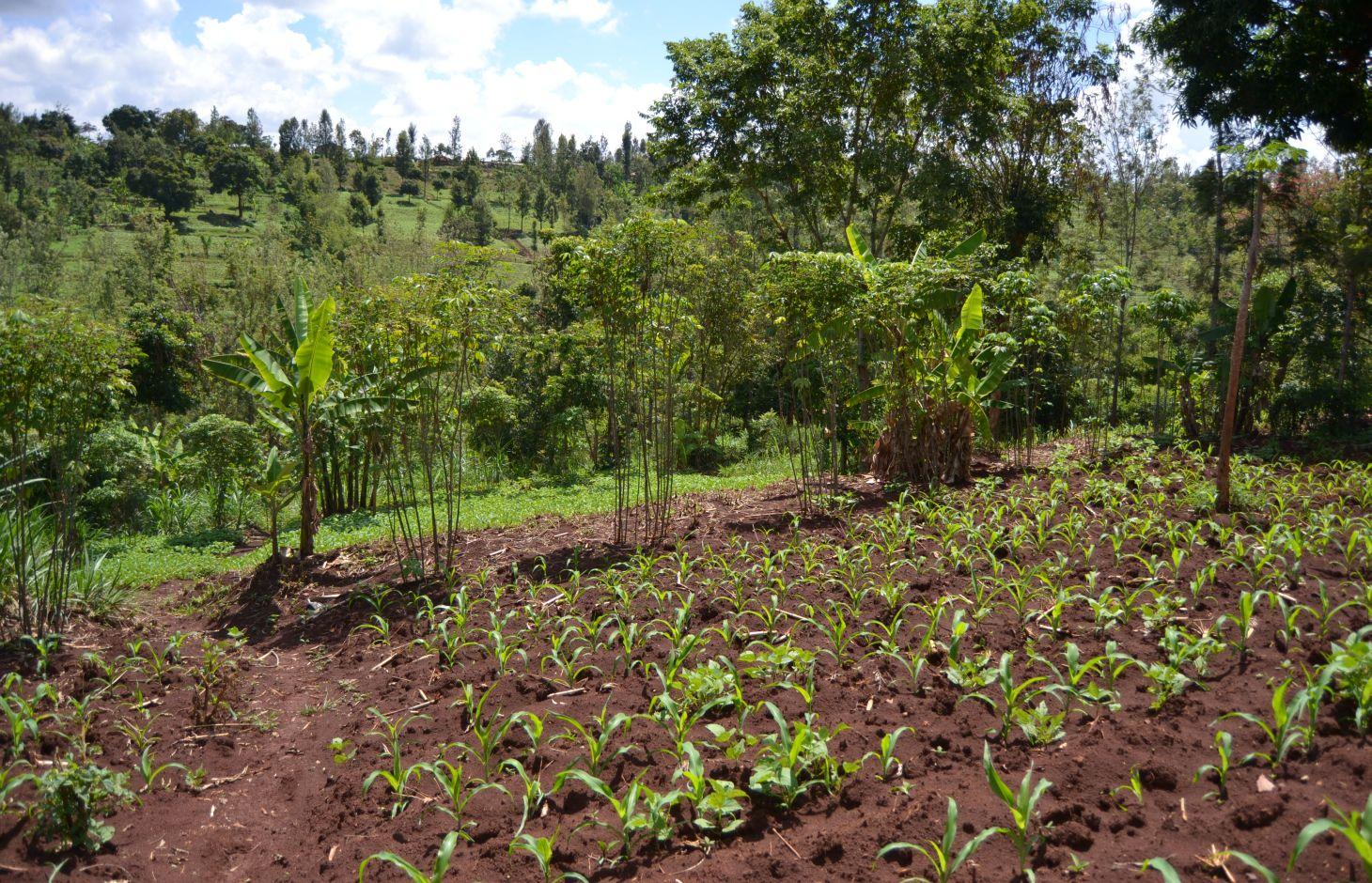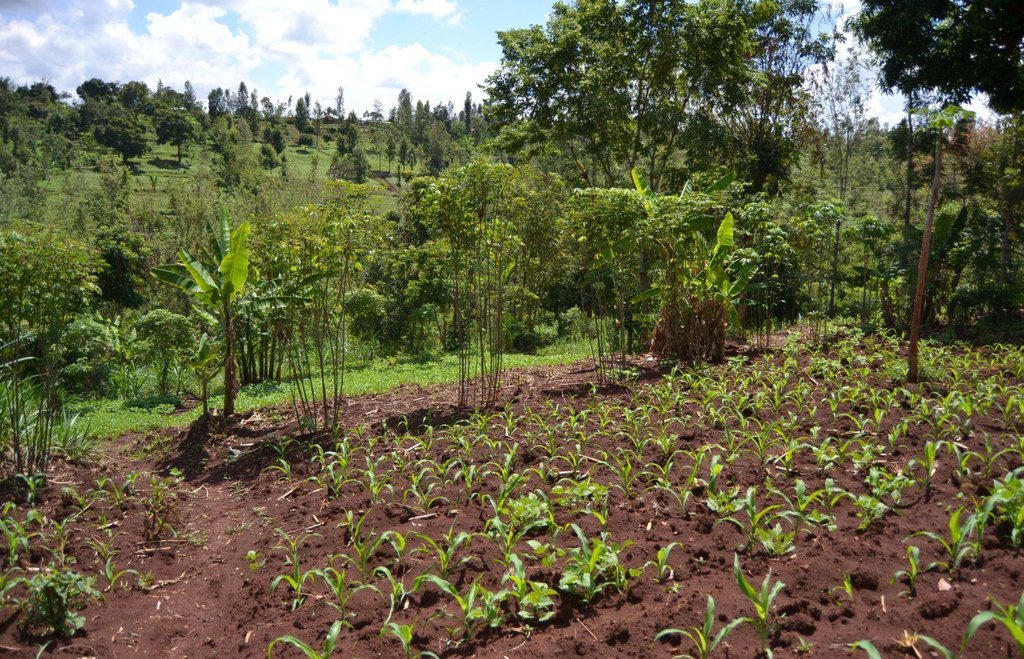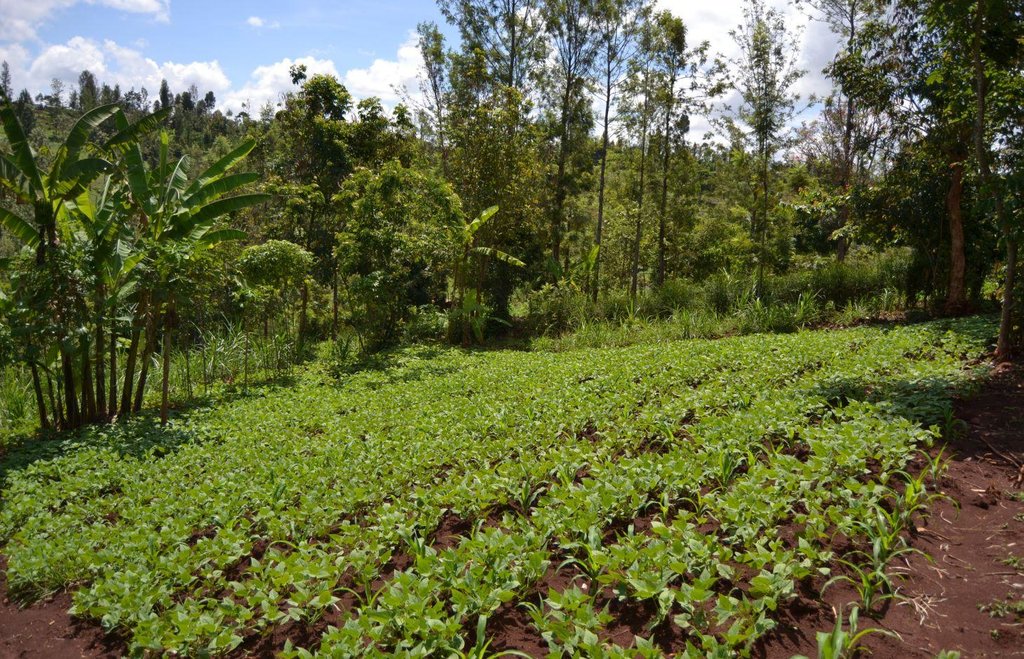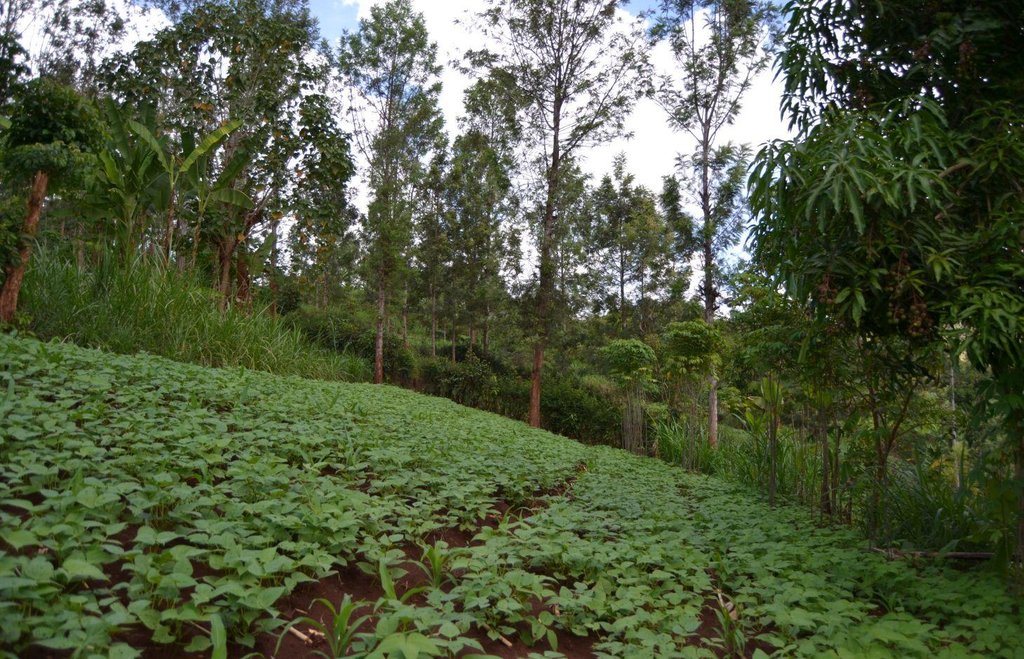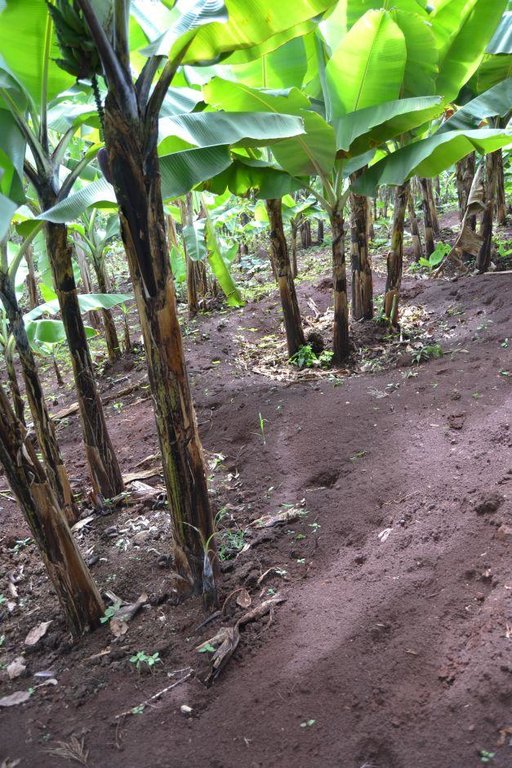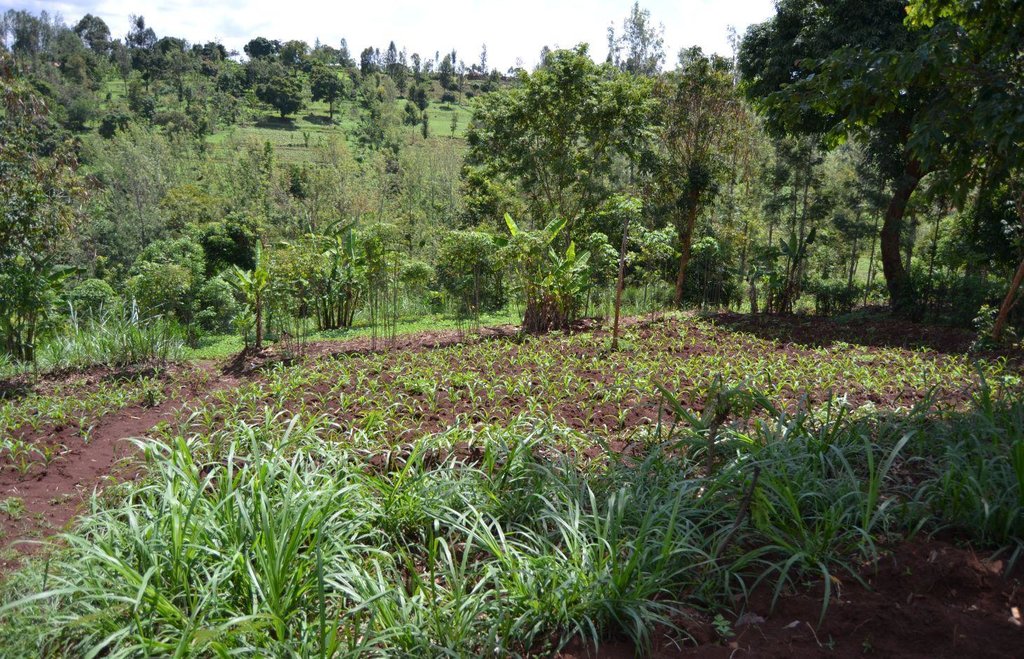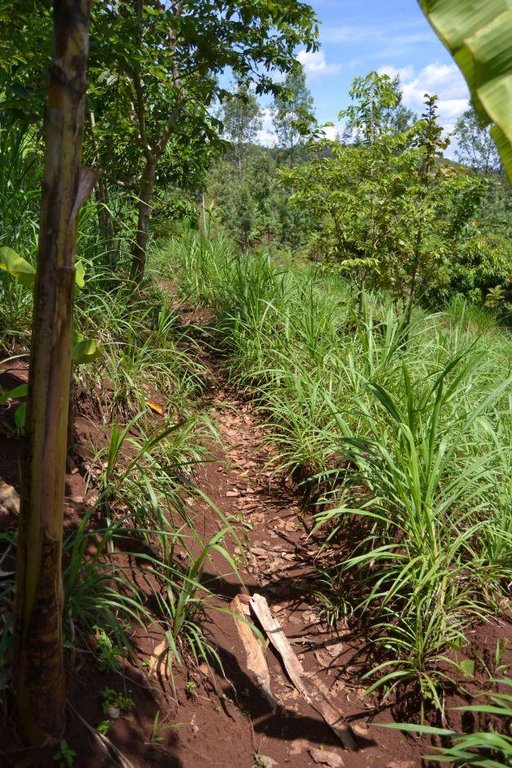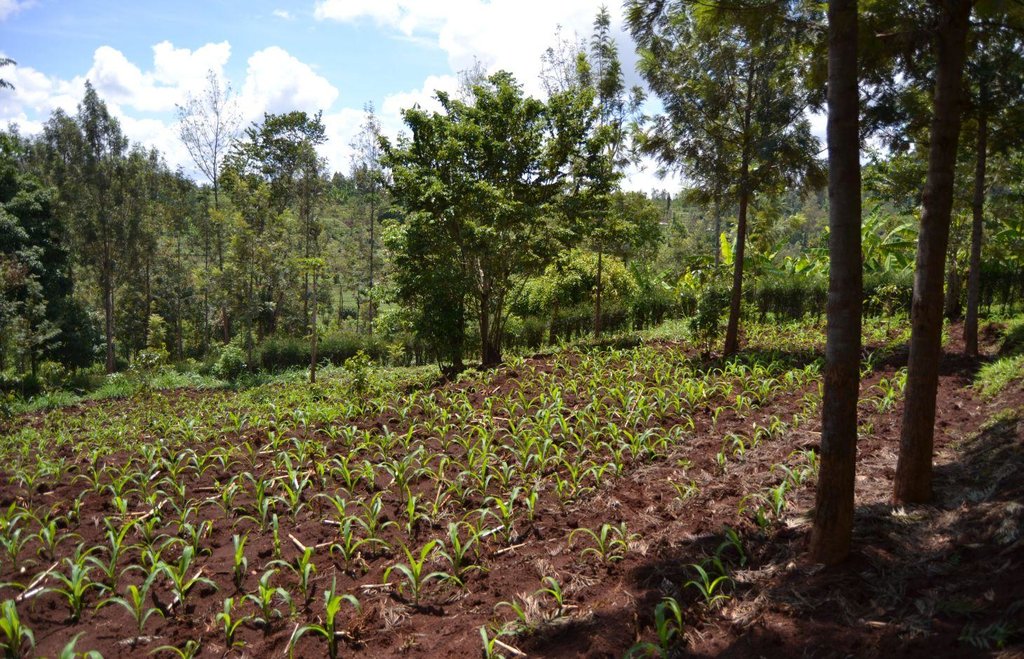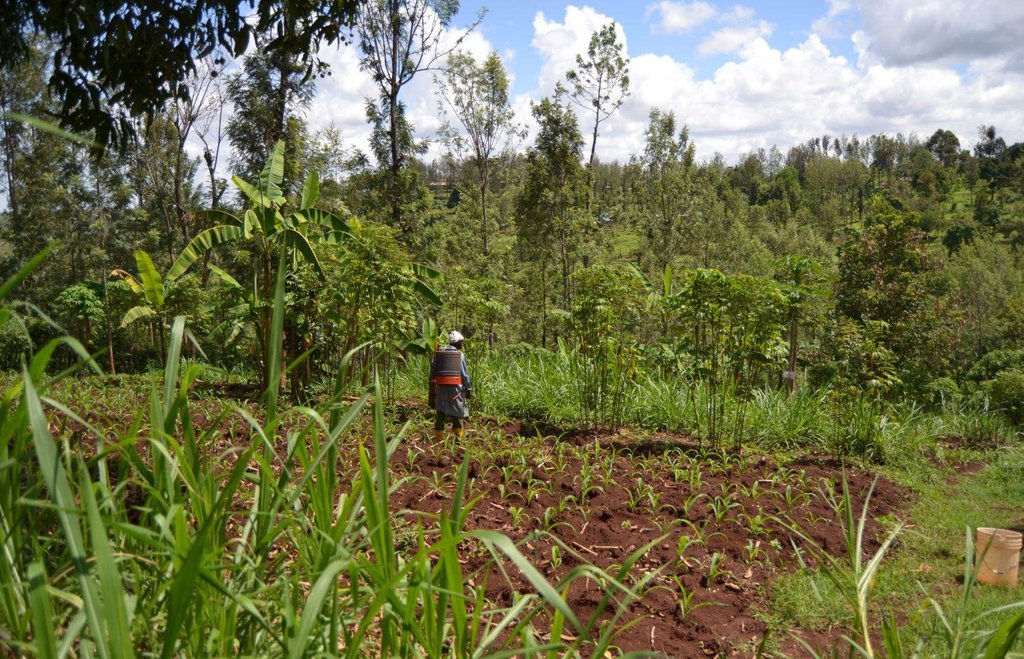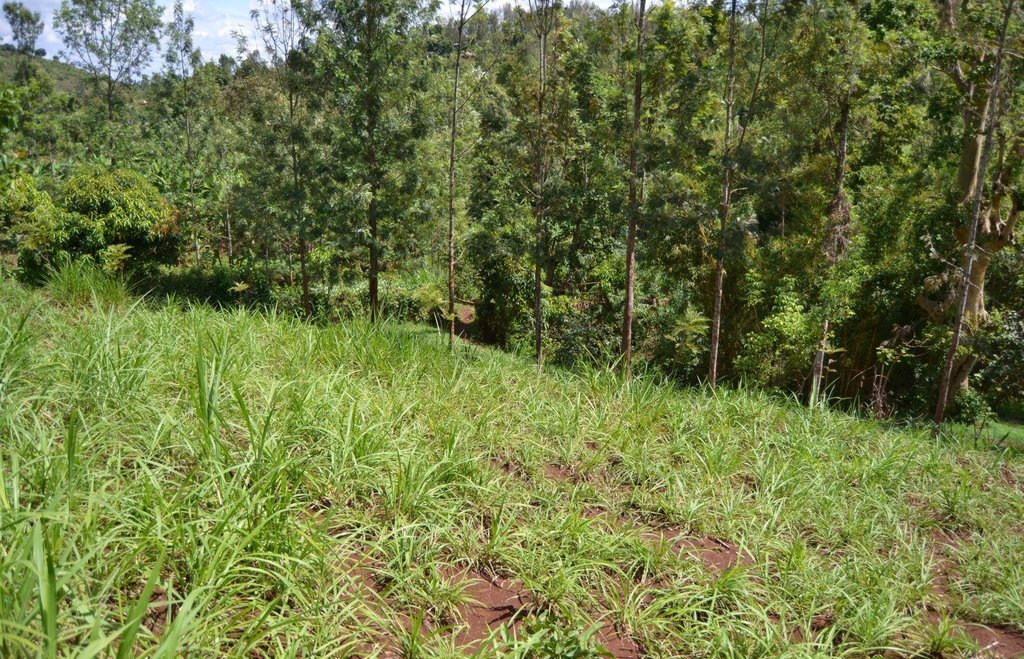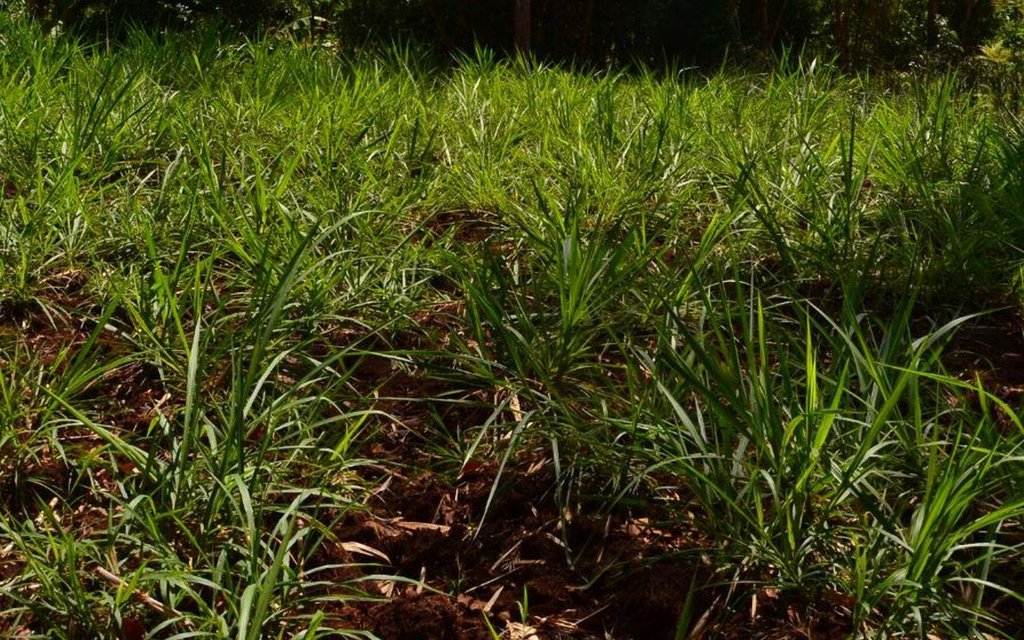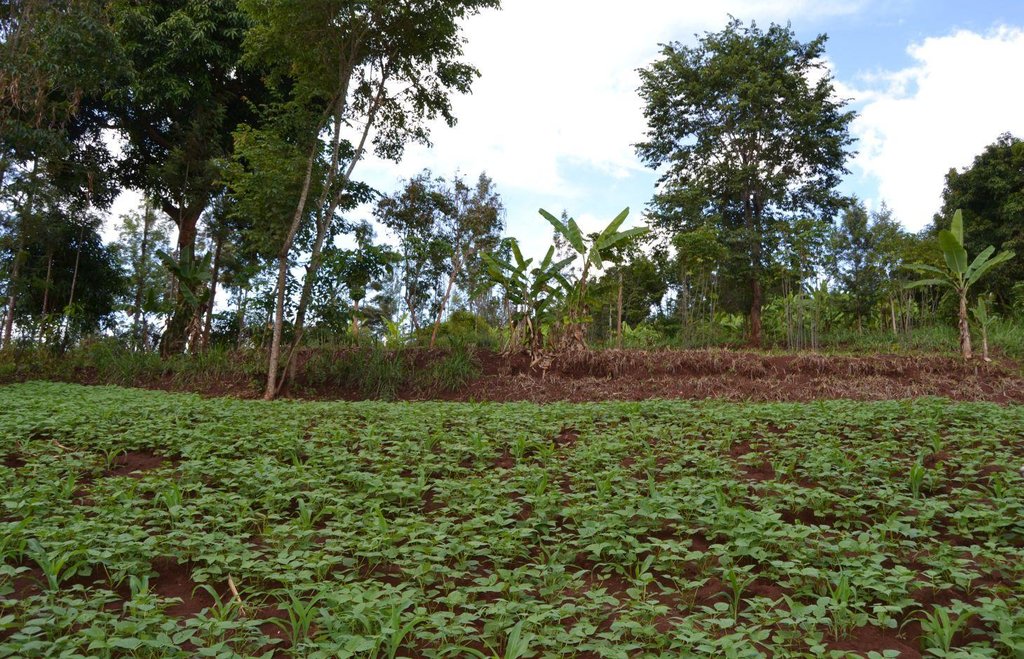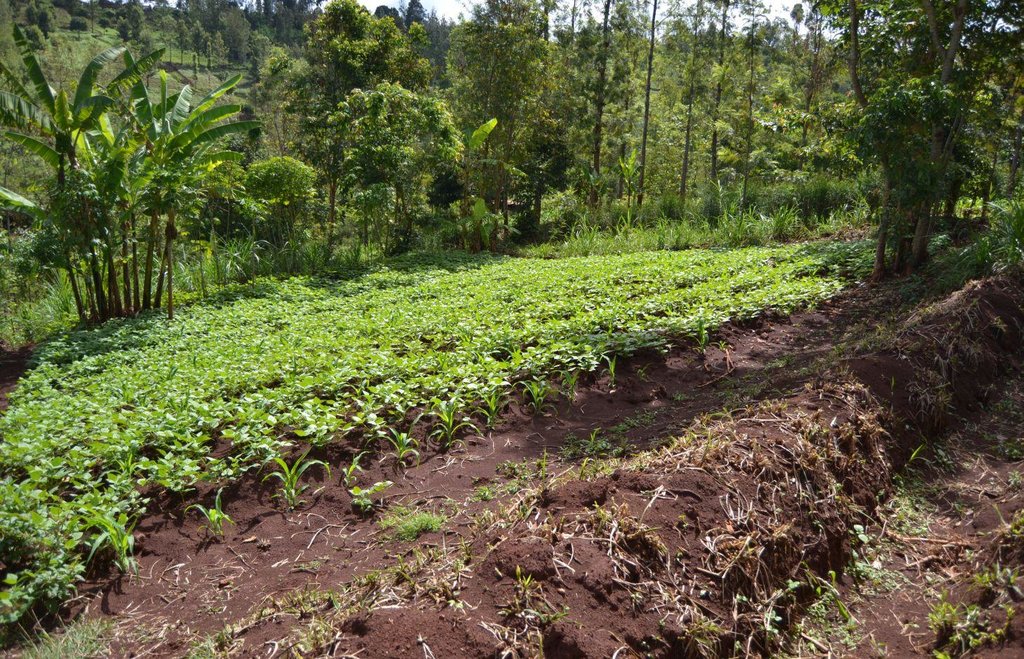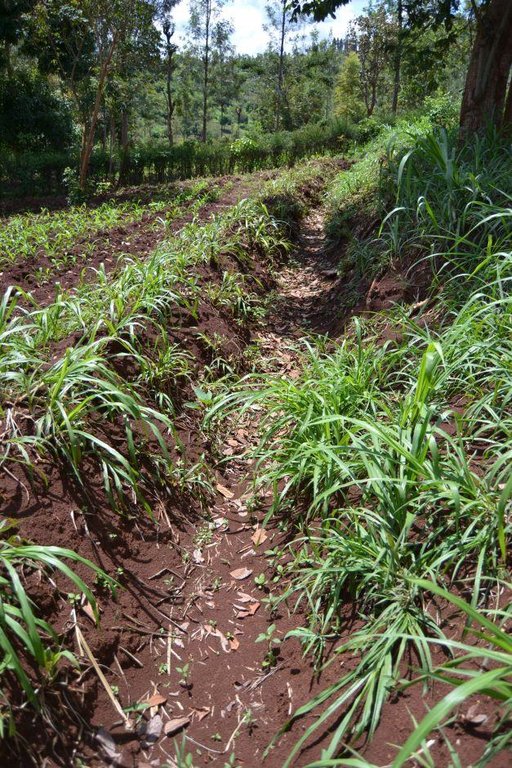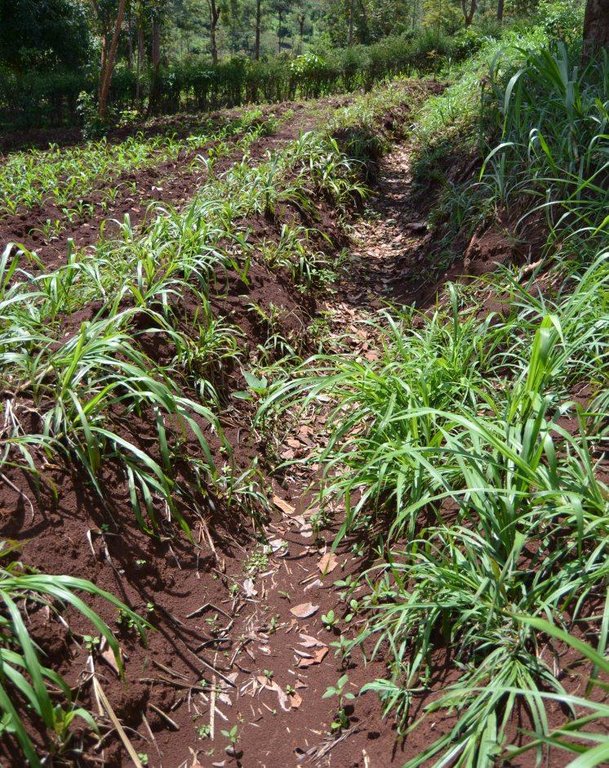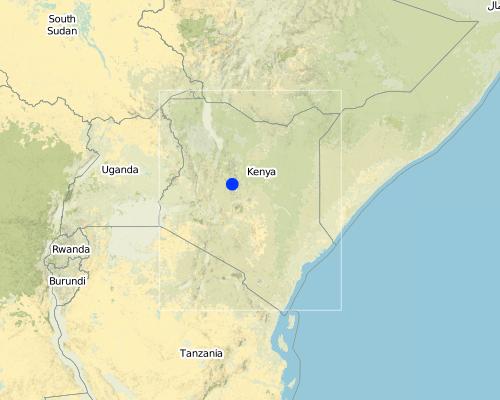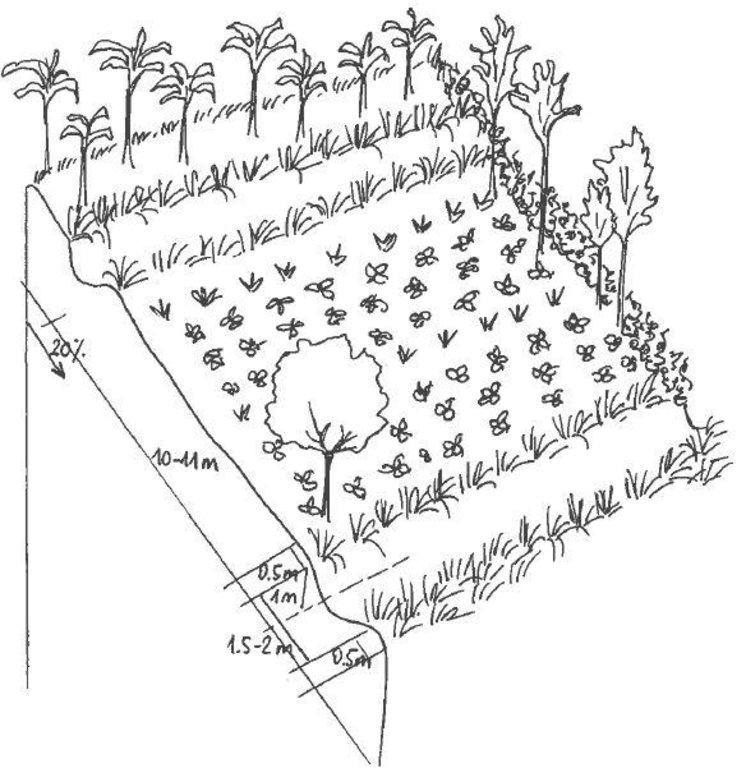Agroforestry system (intercropping beans/maize) with contour ditches, strips of Napier grass, manure and organic fertilizers. [كينيا]
- تاريخ الإنشاء:
- تحديث:
- جامع المعلومات: Laura D'Aietti
- المحرر: –
- المُراجع: Alexandra Gavilano
technologies_1146 - كينيا
- Agroforestry system (intercropping beans/maize) with contour ditches, strips of Napier grass, manure and organic fertilizers.: 28 ديسمبر، 2016 (inactive)
- Agroforestry system (intercropping beans/maize) with contour ditches, strips of Napier grass, manure and organic fertilizers.: 5 يونيو، 2017 (inactive)
- Agroforestry system (intercropping beans/maize) with contour ditches, strips of Napier grass, manure and organic fertilizers.: 7 مايو، 2019 (public)
عرض الأقسام
توسيع الكل طي الكل1. معلومات عامة
1.2 تفاصيل الاتصال بالأشخاص الرئيسيين لمصدر المعلومات والمؤسسات المشاركة في تقييم وتوثيق التقنية
الشخص (الأشخاص) الرئيسي لمصدر المعلومات
متخصص في الإدارة المستدامة للأراضي:
Nyamu Joseph
WRUA Sabasaba
كينيا
1.3 الشروط المتعلقة باستخدام البيانات الموثقة من خلال WOCAT
متى تم تجميع البيانات (ميدانيا)؟:
02/11/2012
يوافق جامع المعلومات والشخص (لاشخاص) الرئيسي لمصدر المعلومات على الشروط المتعلقة باستخدام البيانات الموثقة من خلال WOCAT:
نعم
2. وصف تقنيةالإدارة المستدامي للأراضي
2.1 وصف مختصر للتقنية
تعريف التقنية:
The technology is a combination of agricultural (e.g. intercropping, manure/compost/mulching), vegetative (e.g. Napier grass strips, trees planting) and structural (e.g. ditches) measures which aim to maximise the overall land yield in a sustainable manner (e.g. reducing soil erosion and increasing soil quality).
2.2 وصف تفصيلي للتقنية
الوصف:
The Agroforestry system combines trees plantation (Bananas, Grevillea and Avocados) for fruits and timber collection with cereal crop, maize (Zea mays). Indeed, in order to increase yields, strip intercropping is practiced: cereal crop (maize) is grown in association with pulse (food legumes): beans. Instead of using expensive commercial fertilizers, beans could facilitate maize growth due to the possible transfer of N during growth or after incorporation of the legume biomass, during the growth period of the cereal (Sangakkara et al., 2003). Furthermore, soil quality (e.g. soil structure) is improved because of the increased amount of humus and organic matter and a better soil cover helps in preventing splash erosion and increase soil moisture content and therefore fertility. Indeed, beans have a beneficial impact for weed control (probably due to the shadow effects) and soil moisture content (Worfswinkel, undated; Odhiambo and Ariga, 2001). Planting different crops helps to diversify production and family food supply. Concerning SWC, hillside ditches have been created at the top of each 'terrace' and trees are also planted nearby and Cassava (a drought resistant plant) at the bottom. Manure/compost and organic fertilizers are supplied regularly both on maize/grass (twice a year) and Bananas (once), as good soil management practice. A higher level of organic matter in the soil indicates reduced bulk density, improved soil structure, aeration and higher water holding capacity (Olabode et al., 2007), which altogether improve the physical, chemical and biological properties of the soil (Haering and Evanylo, 2005). Bananas are planted in lines in the upper part of the land. The ditches, large 1m are excavated along the contour; they break slope into shorter segments 11 m long to intercept surface runoff. Ditches also help to prevent soil erosion and to avoid that nutrients and organic matter flow easily downwards into the river, instead they fall into the ditch. A live barrier of Napier grass is present above and below the edge of the five ditches, in two lines, to capture sediments and stabilize the structure, thus it is adequately protected. To conclude, a small area of the land is used to plant Napier grass only for fodder for grazing
Purpose of the Technology: Maize and beans are cultivated for home consumption while Avocados and Bananas are planted for economic (commercial) purposes. Fruits are sold out to the middle-men directly from the house (not at the market), to reduce costs (e.g. transport) and time. Avocados are sold at about 2.5/3 Ksh and Bananas at 200 Ksh. Grevillea trees are considered as saving, and sold out for timber production when the farmer is in need of cash, earning between 800 up to 1500 Ksh, depending on the size-lenght of the tree and the costs for cutting-transportation (e.g. machine operator). In general the selling of timber occurs per feet (running feet). ‘Whole” or standing tree is the preferred mode of selling trees from farms. Negotiation on sales is per tree ‘standing on farm’, with no processing or conversion. Buyers cut and cross cut, and carry timber from farms. Branches and slabs resulting from timber recoveries are left with the farmer depending on price negotiation; if the buyer carries these products then the price of the tree is adjusted upwards (Carsan and Holding , 2006; Holding et al., undated). Furthermore, the farmer underlined how 'bad prunings' at the top of the trees cause holes inside the trunks and thus a higher risk of fungi attacks and other diseases. The majority of the trees are planted along the boundaries of the land, for demarcation and only few are 'dispersed' on the cropland, to avoid excess of shadow to the cereal crop
Establishment / maintenance activities and inputs: High initial input to construct ditches and planting crop; manure also requires regular work: feeding cows and collect droppings and distribute them twice during the year, also over Napier grass. Dry planting is the preferred practice and the seeds are soaked the night before planting; this practice is advisable especially when the growing period is very short (Schmidt et al., 1983); organic fertilizers are applied over maize after 1 week and during the growing period (after about 18 days). Further maintenance is necessary after every rainy season to remove the sediments accumulated into the ditch and for pruning Grevillea, every three seasons. As mentioned above, pruning requires skills and knowledge to avoid plant diseases and labour is expensive because it is high risk work. The farmer trees plantation account for: 15 Avocados (from 4 seedlings), 100 Bananas (from cutting new suckers) and 50 Grevillea trees
Natural / human environment: The area is characterized by rolling-hilly slope and highly exposed to erosion and land degradation: planting trees protect the soil from nutrients leaching and create a litter which reduces evaporation during dry seasons. Concerning the variety of the trees, (e.g. Avocado) the farmer by grafting with better quality branches, improve the quality of the stock trees with certified variesties: out of 4 seedlings of Avocado (10 Ksh each), he has now 15 seedlings of the better (certified) variety called HASS, which performs well at 800-2100 m asl with well distributed annual rainfall of 1000-1200 mm (Youth Agro-environmental initiative website)
2.3 صور التقنية
2.5 البلد/المنطقة/المواقع التي تم تنفيذ التقنية فيها والتي يغطيها هذا التقييم
البلد:
كينيا
المنطقة/الولاية/المحافظة:
Central
مزيد من التفاصيل حول الموقع:
Muthithi location, Kagurumo sublocation
Map
×2.6 تاريخ التنفيذ
في حالة عدم معرفة السنة بالتحديد، يرجى الإشارة إلى التاريخ التقريبي:
- منذ أقل من 10 سنوات (مؤخرًا)
2.7 إدخال التقنية
حدد كيف تم إدخال التقنية:
- من خلال ابتكار مستخدمي الأراضي
التعليقات (نوع المشروع، الخ):
Since the year 2000 the farmer adopted SWC practices in respond to the prolonged degraded situation of the land and its low yields.
3. تصنيف تقنية الإدارة المستدامي للأراضي
3.2 نوع (أنواع) استخدام الأراضي الحالية حيث يتم تطبيق التقنية

أراضي الرعي
الرعي المكثف/ إنتاج الأعلاف:
- قطع وحمل / صفر مرعى
الأنواع والمنتجات الحيوانية الرئيسية:
Cut-and-carry/ zero grazing: Fodder is provided to animals (2 cows) confined to a stall.

مختلطة (محاصيل/ رعي/ أشجار)، بما في ذلك الحراجة الزراعية
- الحراجة الزراعية
التعليقات:
Major land use problems (compiler’s opinion): Sheet erosion with consequent nutrient leaching which could drain into the river.
Major land use problems (land users’ perception): Loss of soil fertility.
Grazingland comments: Fig. 10 Annex 3
Plantation forestry: Yes
Type of grazing system comments: Fig. 10 Annex 3
3.3 مزيد من المعلومات حول استخدام الأراضي
إمدادات المياه للأرض التي يتم تنفيذ التقنية عليها:
- بعلية
عدد مواسم الزراعة في السنة:
- 2
حدد:
Longest growing period in days: 122Longest growing period from month to month: from about March to JuneSecond longest growing period in days: 61Second longest growing period from month to month: from about October to November
كثافة الثروة الحيوانية (إذا كانت ذات صلة):
< 1 LU/km2
3.5 انتشار التقنية
التعليقات:
Total area covered by the SLM Technology is 0.008 m2.
GATWAMIKWA village
3.6 التدابير التقنية في مجال إلادارة المستدامة للأراضي

التدابير الزراعية
- A1: الغطاء النباتي/التربة
- A2: المادة العضوية/خصوبة التربة
- A3: معالجة سطح التربة

التدابير النباتية
- V1: غطاء من الأشجار والشجيرات
- V2: الأعشاب والنباتات العشبية المعمرة

التدابير البنيوية
- S4: تسوية الخنادق والحفر
التعليقات:
Main measures: vegetative measures, structural measures
Secondary measures: agronomic measures
Type of agronomic measures: mulching, legume inter-planting, manure / compost / residues
Type of vegetative measures: aligned: -graded strips *<sup>3</sup>
3.7 الأنواع الرئيسية من تدهور الأراضي التي تناولتها التقنية

تآكل التربة بالمياه
- الوزن(Wt): فقدان التربة السطحية/تآكل السطح

التدهور الكيميائي للتربة
- (Cn): تراجع الخصوبة وانخفاض محتوى المادة العضوية (غير ناتج عن الانجراف)

تدهور المياه
- (Hp): تدهور نوعية المياه السطحية
التعليقات:
Main causes of degradation: soil management (Poor soil management practices.), deforestation / removal of natural vegetation (incl. forest fires) (Poor vegetation cover, mainly herbaceous), disturbance of water cycle (infiltration / runoff) (Steep area (runoff)), Heavy / extreme rainfall (intensity/amounts) (Especially during wet seasons: March-June and October-November), education, access to knowledge and support services (Limited knowledge and training on SWC practices), governance / institutional (Limited or not adequate support)
Secondary causes of degradation: other natural causes (avalanches, volcanic eruptions, mud flows, highly susceptible natural resources, extreme topography, etc.) specify (From gentle to hilly slope), land tenure (Previous poor management SWC measures, especially in the upper areas)
3.8 منع أو حد أو عكس تدهور الأراضي
تحديد هدف التقنية فيما يتعلق بتدهور الأراضي:
- منع تدهور الأراضي
- الحد من تدهور الأراضي
4. المواصفات الفنية، وأنشطة التنفيذ، والمدخلات، والتكاليف
4.1 الرسم الفني للتقنية
4.2 المواصفات الفنية/شروحات الرسم الفني
Agroforestry system, which covers an area of 2 acre. The plot is bordered by Euphorbia tirucalli (Kariaria, milk bush) and Grevillea trees. The ditches are characterized by barriers of Napier grass. Intercropping of maize and beans: the distance from one line of maize and the other is of 1m.
Technical knowledge required for land users: moderate
Main technical functions: control of dispersed runoff: retain / trap, control of dispersed runoff: impede / retard, reduction of slope angle, reduction of slope length, improvement of ground cover, increase of infiltration, increase / maintain water stored in soil, water harvesting / increase water supply, sediment retention / trapping, sediment harvesting
Secondary technical functions: improvement of topsoil structure (compaction), stabilisation of soil (eg by tree roots against land slides), increase in organic matter, increase in nutrient availability (supply, recycling,…), improvement of water quality, buffering / filtering water, increase of biomass (quantity)
Mulching
Material/ species: Organic residues around Banana trees
Quantity/ density: undefined
Legume inter-planting
Quantity/ density: 4 kg
Manure / compost / residues
Material/ species: Leftovers and manure from two cows
Quantity/ density: 8 tonnes
Remarks: (for 1 year). The mix of organic material is left decomposed in a big hole.
Agronomic measure: organic fertilizers
Material/ species: Acid humic and N, P, K, microelements (Biodeposit Elixir: small bags (sachets) of 12 ml)
Remarks: 5 bags (1×12 litre), applied only on maize
Aligned: -graded strips
Vegetative material: T : trees / shrubs, F : fruit trees / shrubs, G : grass
Number of plants per (ha): 100 a strip
Vertical interval between rows / strips / blocks (m): few cm
Spacing between rows / strips / blocks (m): 1
Vertical interval within rows / strips / blocks (m): 0.25
Width within rows / strips / blocks (m): 1
Trees/ shrubs species: Grevillea (Grevillea robusta)
Fruit trees / shrubs species: Avocados (Persea americana- Mũkorobia), Bananas (Musa sapientum- Irigũ)
Grass species: Pennisetum pyramidalis (Napier grass or elephant grass)
Slope (which determines the spacing indicated above): 10%
If the original slope has changed as a result of the Technology, the slope today is (see figure below): 15%
Gradient along the rows / strips: 5-8%
Diversion ditch/ drainage
Spacing between structures (m): 1
Depth of ditches/pits/dams (m): 40/50
Width of ditches/pits/dams (m): 0.6/1
Slope (which determines the spacing indicated above): 5-8%
Lateral gradient along the structure: 15-20%
4.3 معلومات عامة بخصوص حساب المدخلات والتكاليف
عملة أخرى/ عملة وطنية (حدد):
Kenyan Schellings
أشر إلى سعر الصرف من الدولار الأمريكي إلى العملة المحلية (إذا كان ذا صلة): 1 دولار أمريكي =:
85,9
اذكر متوسط تكلفة أجر العمالة المستأجرة في اليوم الواحد:
2.00
4.4 أنشطة التأسيس
| النشاط | نوع التدبير | التوقيت | |
|---|---|---|---|
| 1. | Digging holes (1 feet ×1 feet) and planting trees (e.g. Grevillea trees along the boundaries and in line below the bunds of the ditches) | نباتية | March (before rains), 1 year |
| 2. | Establishment of the ditches(digging ditch and creating soil bunds donward) and terracing. For 1 (in tot. are 5) : 2 p.d. * 1 day at 200 Ksh a day each. | بنيوية أو هيكلية | 2 times per year |
4.5 التكاليف والمدخلات اللازمة للتأسيس
| تحديد المدخلات | الوحدة | الكمية | التكاليف لكل وحدة | إجمالي التكاليف لكل مدخل | % من التكاليف التي يتحملها مستخدمو الأراضي | |
|---|---|---|---|---|---|---|
| العمالة | labour | 1,0 | 7,0 | 7,0 | 100,0 | |
| معدات | Machine to grill/mill maize leftovers (chap cutter) | 1,0 | 1164,0 | 1164,0 | 100,0 | |
| معدات | Generator | 1,0 | 582,0 | 582,0 | 100,0 | |
| غير ذلك | cows 2 | 1,0 | 349,0 | 349,0 | 100,0 | |
| إجمالي تكاليف إنشاء التقنية | 2102,0 | |||||
التعليقات:
Duration of establishment phase: 6 month(s)
4.6 الصيانة/الأنشطة المتكررة
| النشاط | نوع التدبير | التوقيت/الوتيرة | |
|---|---|---|---|
| 1. | Prepare and apply fertilizers (organic) (See Annex 3, Fig. 9&comments) | زراعية | Ferlizer application: after 1 week and 18 days, on maize only |
| 2. | Prepare manure+compost/mulch (Summary 2.1.2 QT4): Labour (to grill/mill leftovers - 300 Ksh for fuel- leftovers to prepare food for cows-3 person days) rest, the farmer by himself feed cows on daily basis (3 times in a day). Fuel: 1litre×1 day (×3 days) | زراعية | compost/manure: 2 times/year in the field+grass; once on Bananas (where also added mulch) |
| 3. | Harvesting maize/beans (around Feb/March and Ag/Sept) | زراعية | 2 times |
| 4. | Apply manure, mulch and compost (during March/April-long rains+Sept) just before the rains, when nutrients infiltrate into the soil with rainwater) (Summary 2.1.2 QT4) | زراعية | Compost/manure: 2 times/year in the field+grass; once on Bananas (where also added mulch) |
| 5. | Tilling-soil (digging holes to plant maize/beans: 7 inches deep (17cm), spaced 1 feet (0.30 m) in contours: dry planting (before rains starts) | زراعية | Twice a year, before rainy season (around March/Sept) |
| 6. | Digging planting holes and planting grass (2 persons × 3 days: 200 Ksh) | نباتية | Every season (March/April and Sept/Oct) |
| 7. | Maintenance (weed control and cutting Napier grass and collecting fodder) (Fig. 11 Annex 3) | نباتية | Every season (March/Sept); cutting Napier: 3/4 times in a season |
| 8. | Pruning branches and let them dry for firewood | نباتية | Every 3 seasons (and when shortage of firewood) |
| 9. | Clearing the tree for selling timber (the price depends also of the use of the chainsaw (or saw) or not | نباتية | When in need of cash (not regularly), not less than 5 years after planting |
| 10. | Repairing the ditches and remove excess of soil/leaves accumulated during the rainy season | بنيوية أو هيكلية | After rains (every season) |
4.7 التكاليف والمدخلات اللازمة للصيانة/للأنشطة المتكررة (سنويًا)
| تحديد المدخلات | الوحدة | الكمية | التكاليف لكل وحدة | إجمالي التكاليف لكل مدخل | % من التكاليف التي يتحملها مستخدمو الأراضي | |
|---|---|---|---|---|---|---|
| العمالة | Labour | 1,0 | 183,0 | 183,0 | ||
| معدات | fuel | 1,0 | 7,0 | 7,0 | ||
| المواد النباتية | seeds | 1,0 | 39,0 | 39,0 | 100,0 | |
| المواد النباتية | fertilizer | 1,0 | 23,0 | 23,0 | 100,0 | |
| إجمالي تكاليف صيانة التقنية | 252,0 | |||||
التعليقات:
Machinery/ tools: the farmer prefers to use fork djembe then just the normal djembe (because it removes better the soil); panga and hoes., shovel, fork djembe, panga, saw, shovels, fork djembe
The costs has been computed during the period of the field visit and it include all the costs for the different structures: agronomic, vegetative and structural measures for 2 acre of land and summarized for 1 year period.
4.8 أهم العوامل المؤثرة على التكاليف
قدم وصفا لأهم العوامل التي تؤثر على التكاليف:
The main environmental constrain is water, in particular during dry season; An important cost is labour required to maintain all the SWC measures.
5. البيئة الطبيعية والبشرية
5.1 المناخ
هطول الأمطار السنوي
- < 250 مم
- 251- 500 ملم
- 501 - 750ملم
- 1,000-751 ملم
- 1,500-1,100 ملم
- 2,000-1,500 ملم
- 3,000-2,001 ملم
- 4,000-3,100 ملم
- > 4000 ملم
المنطقة المناخية الزراعية
- شبه رطبة
Thermal climate class: subtropics. June, July and August
5.2 طوبوغرافيا
متوسط الانحدارات:
- مسطح (0-2%)
- بسيط (3-5%)
- معتدل (6-10%)
- متدحرج (11-15%)
- تلال (16-30%)
- شديدة الانحدار(31-60%)
- فائقة الانحدار (>60%)
التضاريس:
- هضاب/سهول
- أثلام مرتفعة
- المنحدرات الجبلية
- منحدرات التلال
- منحدرات في السفوح
- قاع الوادي
المنطقة الارتفاعية:
- 100-0 متر فوق سطح البحر
- 500-101 متر فوق سطح البحر
- 1,000-501 متر فوق سطح البحر
- 1,500-1,001 متر فوق سطح البحر
- 2,000-1,501 متر فوق سطح البحر
- 2,500-2,100 متر فوق سطح البحر
- 3,000-2,501 متر فوق سطح البحر
- 4,000-3,001 متر فوق سطح البحر
- > 4000 متر فوق سطح البحر
5.3 التربة
متوسط عمق التربة:
- ضحل جدًا (0-20 سم)
- ضحلة (21-50 سم)
- متوسطة العمق (51-80 سم)
- عميقة (81-120 سم)
- عميقة جدًا (> 120 سم)
قوام التربة (التربة السطحية):
- متوسط ( طميي، سلتي)
المواد العضوية في التربة السطحية:
- منخفضة (<1%)
5.4 توافر المياه ونوعيتها
منسوب المياه الجوفية:
> 50 م
توافر المياه السطحية:
متوسط
نوعية المياه (غير المعالجة):
مياه شرب جيدة
5.5 التنوع البيولوجي
تنوع الأنواع:
- متوسط
5.6 خصائص مستخدمي الأراضي الذين يطبقون التقنية
الدخل من خارج المزرعة:
- >50% من إجمالي الدخل
المستوى النسبي للثروة:
- ثري
أفراداً أو مجموعات:
- فرد/أسرة معيشية
مستوى المكننة:
- عمل يدوي
اذكر الخصائص الأخرى ذات الصلة لمستخدمي الأراضي:
Population density: 10-50 persons/km2
Annual population growth: 2% - 3%
Off-farm income specification: The farmer is rich because he owns 3 acre of land and livestock, assets (electricity) which are above the average standards of the community. The farmer is retired from an accountancy service position several years ago.
Market orientation of production system: subsistence (self-supply), subsistence (self-supply), commercial/ market
5.7 متوسط مساحة الأرض المملوكة أو المستأجرة من قبل مستخدمي الأراضي الذين يطبقون التقنية
- < 0.5 هكتارا
- 0.5 - 1 هكتار
- 1 -2 هكتار
- 2 - 5 هكتار
- 5 - 15 هكتار
- 15 - 50 هكتار
- 50 - 100هكتار
- 500-100 هكتار
- 1,000-500 هكتار
- 10,000-1,000 هكتار
- > 10,000 هكتار
5.8 ملكية الأراضي، وحقوق استخدام الأراضي، وحقوق استخدام المياه
ملكية الارض:
- فردية، يوجد سند ملكية
حقوق استخدام الأراضي:
- فردي
حقوق استخدام المياه:
- وصول مفتوح (غير منظم)
التعليقات:
Water use rights depend on the use: open access for drinking and domestic uses.
5.9 الوصول إلى الخدمات والبنية التحتية
الصحة:
- ضعيف
- معتدل
- جيد
التعليم:
- ضعيف
- معتدل
- جيد
المساعدة التقنية:
- ضعيف
- معتدل
- جيد
العمل (على سبيل المثال خارج المزرعة):
- ضعيف
- معتدل
- جيد
الأسواق:
- ضعيف
- معتدل
- جيد
الطاقة:
- ضعيف
- معتدل
- جيد
الطرق والنقل:
- ضعيف
- معتدل
- جيد
مياه الشرب وخدمات الصرف الصحي:
- ضعيف
- معتدل
- جيد
الخدمات المالية:
- ضعيف
- معتدل
- جيد
6. الآثار والتصريحات الختامية
6.1 الآثار التي أظهرتها التقنية في الموقع
الآثار الاجتماعية والاقتصادية
الإنتاج
إنتاج المحاصيل
إنتاج الخشب
الدخل والتكاليف
النفقات على المدخلات الزراعية
دخل المزرعة
الآثار الاجتماعية والثقافية
وضع الفئات المحرومة اجتماعيا واقتصاديا
الآثار الايكولوجية
دورة المياه / الجريان السطحي
الجريان السطحي
التبخر
التربة
رطوبة التربة
غطاء التربة
فقدان التربة
التنوع البيولوجي: الغطاء النباتي، الحيوانات
الكتلة الحيوية/ طبقة الكربون فوق التربة
6.2 الآثار التي أظهرتها التقنية خارج الموقع
توافر المياه
القدرة على التخفيف / الترشيح
6.3 تعرض التقنية وحساسيتها لتغير المناخ التدريجي والظواهر المتطرفة/الكوارث المرتبطة بالمناخ (كما يراها مستخدمو الأراضي)
تغير مناخ تدريجي
تغير مناخ تدريجي
| الموسم | نوع التغير المناخي/ المتطرف | كيف تتعامل التقنية مع ذلك؟ | |
|---|---|---|---|
| درجة الحرارة السنوية | زيادة | غير معروف |
الظواهر المتطرفة / الكوارث المرتبطة بالمناخ
الكوارث الجوية
| كيف تتعامل التقنية مع ذلك؟ | |
|---|---|
| عاصفة ممطرة محلية | جيدا |
| عاصفة هوائية محلية | جيدا |
الكوارث المناخية
| كيف تتعامل التقنية مع ذلك؟ | |
|---|---|
| جفاف | ليس جيدا |
الكوارث الهيدرولوجية
| كيف تتعامل التقنية مع ذلك؟ | |
|---|---|
| فيضان عام (نهر) | جيدا |
العواقب الأخرى المتعلقة بالمناخ
العواقب الأخرى المتعلقة بالمناخ
| كيف تتعامل التقنية مع ذلك؟ | |
|---|---|
| انخفاض فترة النمو | غير معروف |
6.4 تحليل التكلفة والعائد
كيف يمكن مقارنة العوائد نسبة لتكاليف الإنشاء (من وجهة نظر مستخدمي الأراضي)؟
عوائد قصيرة الأجل:
سلبي قليلا
عوائد طويلة الأجل:
إيجابي قليلا
كيف تتم مقارنة العوائدمع كلفة الصيانة/التكاليف المتكررة (من وجهة نظر مستخدمي الأراضي)؟
عوائد قصيرة الأجل:
إيجابي قليلا
عوائد طويلة الأجل:
إيجابي
6.5 اعتماد التقنية
التعليقات:
100% of land user families have adopted the Technology without any external material support
There is a moderate trend towards spontaneous adoption of the Technology
6.7 نقاط القوة / المزايا / الفرص التي توفرها التقنية
| نقاط القوة/ المزايا/ الفرص من وجهة نظر مستخدمي الأراضي |
|---|
| Better yields thanks to the intercropping measures taken. |
| نقاط القوة/ المزايا/ الفرص من وجهة نظر جامع المعلومات أو غيره من الاشخاص الرئيسيين لمصدر المعلومات |
|---|
|
Intercropping is a commonly known practice which improves the overall conditions of the soil and provide better yields. How can they be sustained / enhanced? Besides 'companion planting' there are plants which can be grown as forerunner plants (Storey, 2002). Depending also on the type of soil, attention could be given to some sps. which accumulate concentration of e.g. mineral accumulators, phosporus, potassium, calcium, silica and sulphur . Another way to perhaps enhance the yields is relay intercropping. It is undersowing the next crop into the present crop, so that the present crop is a nurse crop and time and water is saved in the establishment of the following crop (Storey, 2002) Green manure as a way to add organic nutrients and combine more than one green manure and rotate, both legume (e.g. cowpeas, soybeans, annual sweet clover, vetch, sesbania, and velvet beans ) and not legume (e.g. sudangrass, millet, sorghum, and buckwheat). |
|
Agroforestry (Dispersed trees on cropland): The technology is simple to adopt and improves a sustainable land management as well as diversification of income sources and food supply. How can they be sustained / enhanced? It could be implemented by increasing the number of trees planted (e.g. along the boundaries) and with sps. characterised by deeper root systems, to avoid further water competition. More Avocadoe trees could increase the opportunities for the farmer to be part of a CBO (Community Based Organization) addressed to marketing of Avocadoes for oil production. This could help the farmer to earn more money and invest more in SWC implementation and new methods, in the long run. The option of alley cropping (hedgerow Intercropping) with leguminous plants e.g. Sesbanian sesban (Ramachandran Nair-ICRAF, 1993) could be considered as another option. |
|
Napier grass has very good properties in holding soil; also for ditch stabilization and fodder production How can they be sustained / enhanced? Other herbaceous vegetation could be also planted in the field: e.g. Tithonia diversifolia (Mexican sunflower), an excellent (high quality-N, P, K concentration) green manure /nutrient release and medicinal plant, or could be also used as a major component of compost manure. It is an annual weed that can be used for several purposes: fodders, poultry feed, fuel, compost, land demarcation, soil erosion, building materials, shelter for poultry. It is characterized by adaptability to different environment, rapid growth, fast rate of decomposition. Nevertheless, there is the need to ascertain the extent to which this weed sps. could be used for soil improvement and to determine the best mode of application of the weed sps., (Olabode et al., 2007, Olubukola et al., 2013) and the fact that is a invasive weed (with an aggressive growth) it requires a good knowledge in the land management and weed control. |
| The attention to certified varieties give also more value to the production itself and at market level: an increase of the bargaining power creates more opportunities for better income and chances to explore new and bigger markets, (e.g. Avocados for oil production ). |
6.8 نقاط ضعف / مساوىء / مخاطر التقنية وسبل التغلب عليها
| نقاط الضعف/ المساوىء/ المخاطر من وجهة نظر جامع المعلومات أو غيره من الاشخاص الرئيسيين لمصدر المعلومات | كيف يمكن التغلب عليها؟ |
|---|---|
| The technologies in place require maintenance and monitoring, especially during rainy seasons | Eventually subsides or be part of a CBO's (Community Based Organizations) or SHG (Self Help Groups); Still the measures already in place could be improved: diversification of trees (e.g. indigenous) and trainings (e.g. pruning etc) could help the farmer in avoiding tree diseases and allocate more efficiently resources. |
| The amount of work required to carry out all the activities is too much. |
7. المراجع والروابط
7.2 المراجع للمنشورات المتاحة
العنوان، المؤلف، السنة، النظام القياسي الدولي لترقيم الكتب ISBN:
Holding C., Carsan S., Njuguna P., 2004. Smallholder Timber Marketing: A Kenyan Experience. FAO/ICRAF/GoK multi-stakeholder programme. International Workshop on small holder timber production.
العنوان، المؤلف، السنة، النظام القياسي الدولي لترقيم الكتب ISBN:
Odhiambo G.D. and Ariga E. S., 2001. Effect of intercropping maize and beans on Striga incidence and grain yield. Seventh Eastern and Southern Africa Regional Maize Conference. 11th -15 th February, 2001. pp. 183-186.
العنوان، المؤلف، السنة، النظام القياسي الدولي لترقيم الكتب ISBN:
Olabode O.S., Sola O., Akanbi W.B., Adesina G.O., Babajide P.A., 2007. Evaluation of Tithonia diversifolia (Hemsl.) A Gray for Soil Improvement. World Journal of Agricultural Sciences 3 (4): 503-507.
متاح من أين؟كم التكلفة؟:
http://www.idosi.org/wjas/wjas3(4)/15.pdf
العنوان، المؤلف، السنة، النظام القياسي الدولي لترقيم الكتب ISBN:
Olubukola S. A., Aderemi Ojo Ezekiel-Adewoyin O., Dorcas Tinuke D., Akintoye Henry, 2010. Comparing the use of Tithonia diversifolia and Compost as soil amendments for growth and yield of Celosia argentea. New York Science Journal 3 (6).
متاح من أين؟كم التكلفة؟:
http://www.sciencepub.net/newyork/ny0306/20_2680_ny0306_133_138.pdf
العنوان، المؤلف، السنة، النظام القياسي الدولي لترقيم الكتب ISBN:
Ramachandran Nair P. K., 1993. An Introduction to Agroforestry- ICRAF.
متاح من أين؟كم التكلفة؟:
http://www.worldagroforestry.org/units/library/books/PDFs/32_An_introduction_to_agroforestry.pdf?n=161
العنوان، المؤلف، السنة، النظام القياسي الدولي لترقيم الكتب ISBN:
Sanchez M. A., 2012. Food vs wood: dynamic choices for Kenyan smallholders. A plan B research paper. Master of Science. Michigan State University.
متاح من أين؟كم التكلفة؟:
http://ageconsearch.umn.edu/bitstream/134024/2/PeraltaSanchezPlanB.pdf
العنوان، المؤلف، السنة، النظام القياسي الدولي لترقيم الكتب ISBN:
Sangakkara U.R., Richner W., Schneider M. K., Stamp P., 2003. Impact of intercropping beans (Phaseolus vulgaris L.) and sunhemp (Crotalaria juncea L.) on growth yields and Nitrogen uptake of maize (Zea mays L.) grown in the humid tropics during the minor rainy season. Maydica 48: 233-238
متاح من أين؟كم التكلفة؟:
http://www.maydica.org/articles/48_233.pdf
العنوان، المؤلف، السنة، النظام القياسي الدولي لترقيم الكتب ISBN:
Schmidt H., Swoboda R., Ralph Jätzold R., 1983. Farm Management Handbook of Kenya. Natural Conditions and Farm Management Information. Vol. 2.Part B: Central Kenya
متاح من أين؟كم التكلفة؟:
http://www2.gtz.de/dokumente/bib/07-1284.pdf
العنوان، المؤلف، السنة، النظام القياسي الدولي لترقيم الكتب ISBN:
Smith D. M., Jackson N. A., Roberts J.M. and Ong C.K., 1999. Root distributions in a Grevillea robusta-maize agroforestry system in semi-arid Kenya. Plant and Soil 211: 191–205, 1999.
العنوان، المؤلف، السنة، النظام القياسي الدولي لترقيم الكتب ISBN:
Storey P. J., 2002. The conservation and improvement of sloping land. Volume 1: Practical understanding. Chapter 5: Improving the soil management.
العنوان، المؤلف، السنة، النظام القياسي الدولي لترقيم الكتب ISBN:
Worfswinkel van M., undated. Intercropping of Annual Foodcrops, Agrobrief (Agromisa), N.4
متاح من أين؟كم التكلفة؟:
http://www.allindiary.org/pool/resources/intercropping.pdf
العنوان، المؤلف، السنة، النظام القياسي الدولي لترقيم الكتب ISBN:
Carsan S., Holding C., 2006. Growing farm timber: practices, market and policies. The Meru timber marketing pilot programme case studies and reviews. World Agroforestry Centre.
متاح من أين؟كم التكلفة؟:
http://www.worldagroforestry.org/downloads/publications/PDFs/b14639.pdf
العنوان، المؤلف، السنة، النظام القياسي الدولي لترقيم الكتب ISBN:
Chia-Chun Wu, 1998. Effective conservation practices for the cultivation of slopelands, Extension Bulletin (ASPAC/FFTC), No. 449, 7 p.
متاح من أين؟كم التكلفة؟:
http://www.fao.org/prods/gap/database/gap/files/1272_CONSERVATION_ON_SLOPES.PDF
العنوان، المؤلف، السنة، النظام القياسي الدولي لترقيم الكتب ISBN:
Crozier C., 1986. Soil Conservation Techniques for Hillside Farms. A Guide for Peace Corps Volunteers. Appropriate Technologies for Development. Peace Corps Information Collection & Exchange Reprint Series No. R-62. Peace Corps Institution.
متاح من أين؟كم التكلفة؟:
(The Humanity Development Library website: http://www.nzdl.org/gsdlmod?a=p&p=home&l=en&w=utf-8)
العنوان، المؤلف، السنة، النظام القياسي الدولي لترقيم الكتب ISBN:
CSIRO (Baldock J.) Soil carbon: the basics. website (http://www.csiro.au/en/Outcomes/Environment/Australian-Landscapes/soil-carbon.aspx) . Also in: Carbon Farming Fact Sheet: Store carbon for healthy soils and better yields.
متاح من أين؟كم التكلفة؟:
http://www.grdc.com.au/uploads/documents/GRDC_CarbonFarming_4pp.pdf
العنوان، المؤلف، السنة، النظام القياسي الدولي لترقيم الكتب ISBN:
Elemans A., 2011. Thesis report (unpublished): Green water credits program in Saba Saba sub-catchment in the Upper Tana, Kenya.
العنوان، المؤلف، السنة، النظام القياسي الدولي لترقيم الكتب ISBN:
Gutteridge R. C. and Sheltong H. M., 1998.eridge R. C. and Shelton H. M., 1998. Forage tree legumes in tropical agriculture. (http://www.fao.org/ag/AGP/AGPC/doc/PUBLICAT/Gutt-shel/x5556e00.htm Chapter 5.2
متاح من أين؟كم التكلفة؟:
http://www.fao.org/ag/AGP/AGPC/doc/Publicat/Gutt-shel/x5556e0q.htm
العنوان، المؤلف، السنة، النظام القياسي الدولي لترقيم الكتب ISBN:
HDRA , undated. Agroforestry in the Tropics.
متاح من أين؟كم التكلفة؟:
http://www.thenrgroup.net/member/MRO/AER/AER-560.htm
العنوان، المؤلف، السنة، النظام القياسي الدولي لترقيم الكتب ISBN:
Haering, K., Evanylo G., 2005. Composting and Compost Use for Water Quality. In Composting resource directory. Mid-Atlantic Reg. Water Program.
متاح من أين؟كم التكلفة؟:
http://infohouse.p2ric.org/ref/41/40137.pdf
العنوان، المؤلف، السنة، النظام القياسي الدولي لترقيم الكتب ISBN:
Holding C., Carsan S., Njuguna P., undated. Smallholder timber and firewood marketing in the coffee and cotton/tobacco zones of eastern Mount Kenya. In: Small-scale forestry and rural development: The intersection of ecosystems, economics and society.
متاح من أين؟كم التكلفة؟:
http://www.coford.ie/media/coford/content/publications/projectreports/small-scaleforestryconference/Holding.pdf
الروابط والوحدات المواضيعية
توسيع الكل طي الكلالروابط
لا يوجد روابط
الوحدات المواضيعية
لا يوجد وحدات مواضيعية


